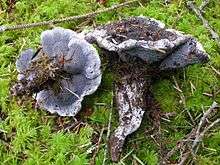Hydnellum cyanopodium
Hydnellum cyanopodium, commonly known as the blue foot[2] or bleeding blue tooth,[1] is an inedible fungus in the family Bankeraceae. It occurs in the Pacific Northwest region of North America.
| Hydnellum cyanopodium | |
|---|---|
 | |
| Hydnellum cyanopodium | |
| Scientific classification | |
| Kingdom: | Fungi |
| Division: | Basidiomycota |
| Class: | Agaricomycetes |
| Order: | Thelephorales |
| Family: | Bankeraceae |
| Genus: | Hydnellum |
| Species: | H. cyanopodium |
| Binomial name | |
| Hydnellum cyanopodium K.A.Harrison (1964) | |
Taxonomy
The fungus was described as new to science to Canadian mycologist Kenneth A. Harrison in 1964.[3] The type was collected by Alexander H. Smith in Crescent City, California, on November 1937. It is kept at University of Michigan Herbarium.[4] Harrison considered this species—in addition to H. cruentum and H. scleropodium—to be members of the stirps (species thought to be descendants of a common ancestor) he called "cruentum". This stirps is characterized by the presence of red juice drops on young fruit bodies, bluish spines, and similar spore morphology.[3]
Description
The fruit bodies have irregularly shaped caps measuring 4–8 cm (1.6–3.1 in) in diameter. The cap surface is rough with small hard points, has ridges, and is a dark blue-wine red color that changes later to lavender. The outer cap edge turns whitish with age. Young fruit bodies are covered with drops of red juice. The flesh has a woody or cork-like texture, and a strong, "disagreeable" odor and taste.[3]
The spines on the underside of the caps are up to 3 mm long with a color ranging from initially grayish violet blue to wine-blue with brownish tints, to dull grayish-green. The stipe measures 2–5 cm (0.8–2.0 in) long by 1–2 cm (0.4–0.8 in) thick, and tends to root into the ground. Its color is deep bluish-black (with similarly colored flesh within) with a whitish mycelium at the base. Staining the spines or the cap or stipe flesh with potassium hydroxide turns it blue-green. Spores are angular, cross-shaped with four to six thick points, and measure 4–5 by 3.5–4.5 µm. The spore shape has been likened to jacks.[3]
Similar species
The lookalike species Hydnellum caeruleum can be readily distinguished from H. cyanopodium by its lack of a medicinal odor, the absence of red juice drops, and the orange to rusty-brown color of its stipe. H. caeruleum can be further distinguished microscopically by its roughly spherical spores.[2] H. scleropodium has a smoother texture and more pallid colors. H. cruentum, found in Nova Scotia, Canada, has an odor that has been described as "medicinal".[3]
Habitat and distribution
Hydnellum cyanopodium fruits singly, in groups, or with fruit bodies fused together. It occurs under Sitka spruce (Picea sitchensis) and pine (Pinus spp.) in California.[3] The fungus is also found in Oregon.[5]
See also
References
- Siegel, N. (25 April 2016). "Hydnellum cyanopodium". IUCN Red List of Threatened Species. 25 April 2016. doi:10.2305/IUCN.UK.2017-3.RLTS.T95384499A95385474.en.
- McKnight KH. (1998). A Field Guide to Mushrooms: North America. Houghton Mifflin Harcourt. p. 93. ISBN 978-0-395-91090-0.
- Harrison KA. (1964). "New or little known North American stipitate Hydnums". Canadian Journal of Botany. 42 (9): 1205–33. doi:10.1139/b64-116.
- "Hydnellum cyanopodium; Hydnaceae". Fungus Collection Database. University of Michigan. Retrieved 2014-06-01.
- "Hydnellum cyanopodium". Consortium of Pacific Northwest Herbaria. Retrieved 2014-06-01.
